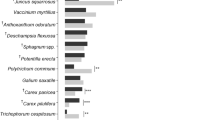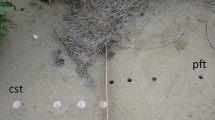Abstract
Foraging decisions are an integral component of growth and maintenance and may reflect both environmental and genetic effects. We used a common garden experiment to evaluate the effects of food, temperature, and population source on pit-building decisions of the larval ant lion Myrmeleon immaculatus. In a laboratory common garden experiment, first-instar larvae from two southern (Georgia, South Carolina) and two northern (Connecticut, Rhode Island) populations were reared for 14 months in incubators under high- and low-food and high- and low-temperature regimes. For all populations, there was no effect of larval age on pit-building behavior. All larvae built and maintained pits more frequently at high temperatures than at low temperatures, and larvae in the low-food treatments built and maintained pits more frequently than larvae in the high-food treatments. Larvae from the southern populations built and maintained pits more frequently than larvae from northern populations. These results suggest that regional differences in foraging behavior may contribute to latitudinal gradients in life history strategies seen in this insect.
Similar content being viewed by others
REFERENCES
Abrams, P. A. (1991). Life history and the relationship between food availability and foraging effort. Ecology 72: 1242–1252.
Arnett, A. E., and Gotelli, N. J. (1999a). Geographic variation in life-history traits of the ant lion, Myrmeleon immaculatus: Evolutionary implications of Bergmann's rule. Evolution 53(4): 1180–1188.
Arnett, A. E., and Gotelli, N. J. (1999b). Bergmann's rule in the ant lion Myrmeleon immaculatus (Neuroptera: Myrmeleontidae): Geographic variation in body size and heterozygosity. J. Biogeogr. 26: 275–283.
Bautista, L. M., Tinbergen, J., Wiersma, P., and Kacelnik, A. (1998). Optimal foraging and beyond: How starlings cope with changes in food availability. Am. Nat. 152: 543–561.
Dukas, R. (1998). Cognitive Ecology, University of Chicago Press, Chicago.
Furunishi, S., and Masaki, S. (1981). Photoperiodic response of the univoltine ant-lion Myrmeleon formicarius (Neuroptera, Myrmeleontidae). Kontyu 49: 653–667.
Furunishi, S., and Masaki, S. (1982). Seasonal life cycle in two species of ant-lion (Neuroptera: Myrmeleontidae). Japan. J. Ecol. 32: 7–13.
Galis, F. (1990). Ecological and morphological aspects of changes in food uptake through the ontogeny of Haplochromis piceatus. In Hughes, R. N. (ed.), Behavioural Mechanisms of Food Selection, Springer-Verlag, Berlin, Heidelberg.
Gilchrist, H. G., Gaston, A. J., and Smith, J. N. M. (1998). Wind and prey nest sites as foraging constraints on an avian predator, the glaucous gull. Ecology 79: 2403–2414.
Gotelli, N. J. (1993). Ant lion zones: Causes of high-density predator aggregations. Ecology 74: 226–237.
Gotelli, N. J. (1996). Ant community structure: Effects of predatory ant lions. Ecology 77: 630–638.
Gotelli, N. J. (1997). Competition and coexistence of larval ant lions. Ecology 78: 1761–1773.
Girffiths, D. (1980). The feeding biology of ant-lion larvae: Prey capture, handling and utilization. J. Anim. Ecol. 49: 99–125.
Griffiths, D. (1991). Food availability and the use and storage of fat by ant-lion larvae. Oikos 60: 162–172.
Kamil, A. C., and Sargent, T. D. (1981). Foraging Behaviour: Ecological, Ethological, and Psychological Approaches, Garland Press, New York.
Lima, S. L., and Dill, L. M. (1990). Behavioral decisions made under the risk of predation: A review and prospectus. Can. J. Zool. 68: 619–640.
Linton, M.C., Crowley P. H., Williams, J. T., Dillon, P. M., Aral, H., Strohmeier, K. L., and Wood, C. (1991). Pit relocation by antlion larvae: A simple model and laboratory test. Evolut. Ecol. 5: 93–104.
Lokkeborg, S. (1998). Feeding behaviour of cod, Gadus morhua: Activity rhythm and chemically mediated food search. Anim. Behav. 56: 371–378.
Lubin, Y., and Henschel, J. (1996). The influence of food supply on foraging behaviour in a desert spider. Oecologia 105: 64–73.
Lucas, J. R. (1985). Metabolic rates and pit-construction costs of two antlion species. J. Anim. Ecol. 54: 295–309.
Lucas, J. R. (1986). Antlion pit construction and kleptoparasitic prey. Fla. Entomol. 69: 702–709.
Machmer, M. M., and Ydenbergl, R. C. (1990). Weather and osprey foraging energetics. Can. J. Zool. 68: 40–43.
Mangel, M., and Clark, C. W. (1988). Dynamic Modeling in Behavioral Ecology, Princeton University Press, Princeton, NJ.
Mappes, T. (1998). High population density in bank voles stimulates food hoarding after breeding. Anim. Behav. 55: 1483–1487.
Matsura, T., and Takano, H. (1989). Pit-relocation of antlion larvae in relation to their density. Res. Popul. Ecol. 31: 225–234.
McEdward, L. R. (1997). Reproductive strategies of marine benthic invertebrates revisited: Facultative feeding by planktotrophic larvae. Am. Nat. 150: 48–72.
McNamara, J. M., and Houston, A. I. (1997). Currencies for foraging based on energetic gain. Am. Nat. 150: 603–617.
Mousseau, T. A. (1991). Geographic variation in maternal-age effects on diapause in a cricket. Evolution 45: 1053–1059.
Norris, K., and Johnstone, I. (1998). Interference competition and the functional response of oystercatchers searching for cockles by touch Anim. Behav. 56: 639–650.
Pravosudov, V. V., and Grubb, T. C., Jr. (1998). Management of fat reserves in tufted titmice Baelophus bicolor in relation to risk of predation. Anim. Behav. 56: 49–54.
Roff, D. A. (1992). The Evolution of Life Histories: Theory and Analysis, Chapman & Hall, New York.
Rotenberry, J. T., and Wiens, J. A. (1998). Foraging patch selection by shrubsteppe sparrows. Ecology 79: 1160–1173.
SAS Institute Inc. (1994). JMP Statistics for the Apple Macintosh from SAS Institute Inc.: Statistics and Graphics Guide, Version 3, SAS Institute Inc., Cary, NC.
Skelly, D. K., and Werner, E. E. (1990). Behavioral and life-historical responses of larval American toads to an odonate predator. Ecology 71: 2313–2322.
Weetman, D., Atkinson, D., and Chubb, J. C. (1998). Effects of temperature on antipredator behaviour in guppy, Poecilia reticulata. Anim. Behav. 55: 1361–1372.
Author information
Authors and Affiliations
Corresponding author
Rights and permissions
About this article
Cite this article
Arnett, A.E., Gotelli, N.J. Pit-Building Decisions of Larval Ant Lions: Effects of Larval Age, Temperature, Food, and Population Source. Journal of Insect Behavior 14, 89–97 (2001). https://doi.org/10.1023/A:1007853730317
Issue Date:
DOI: https://doi.org/10.1023/A:1007853730317




